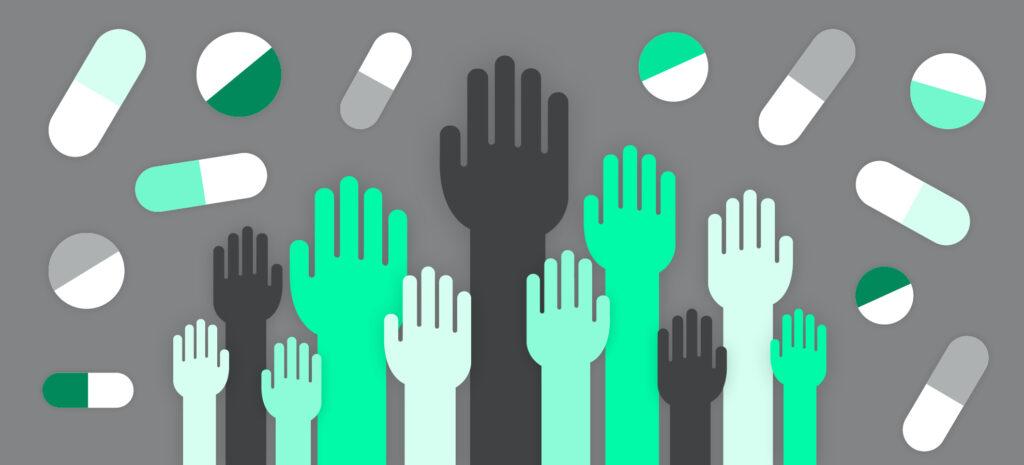Historically, traditional clinical trials have been the primary data source that life science companies utilize when making health-related decisions. However, as PharmaVoice notes, the clinical trial data has “well-known limitations that make it difficult to generalize findings to larger, more inclusive populations of patients, providers, and healthcare delivery systems or settings reflective of actual use in practice.”
Put simply, serious insight gaps arise in clinical research that can separate the sterile and controlled setting of medical trials from the exogenous factors—genetic, behavioral, environmental, and societal influences—that impact real-world applications and the health outcome of patient populations.
With the rapid integration of real-world data (RWD) and real-world evidence (RWE) into healthcare delivery, there is now a holistic, data-driven approach used by life science companies to bridge this divide in study design.
What is real-world data?
The digital age has led to the rapid acceleration of health-related data.
Wearables, computers, mobile phones, and other IoT devices have made it possible to gather and store troves of real-world data (RWD). Life science companies are leveraging this data to make better decisions and deliver high-quality, continual health care.
Unlike clinical trial design, real-world data refers to data generated from various sources that relate to the patient’s health status, delivery of care, and other crucial data points. The key difference between the two is that the real-world data comes from outside of a clinical setting, making the data representative of real-world care and outcomes.
While this data may be gathered from several sources, it can be typically separated into one of five buckets:
Clinical data
Data collected and recorded by care providers during the delivery of care. Most of this comes from electronic health records (EHR data) and case report forms. The data may include:
- Demographic information
- Medical history
- Diagnostic test results
- Medications
- Lab results
- Imaging studies
- Product and disease registries
Administrative or claims data
Data generated by healthcare payers on the utilization and cost of healthcare services, using claims datasets. This may include diagnoses, treatments, and costs associated with care delivery.
Patient-generated (or “reported”) data
Data generated by the patient themselves. This is often gathered through wearables, mobile apps, or other self-monitoring data collectors. This data is stored in an electronic medical record and may cover health & treatment history, biometric data, and patient-reported outcomes.
Emerging data
Data generated by new sources, such as social media, cross-industry data collaborations, patient advocacy groups, and IoT technologies.
Public health data
Data from various government sources, national networks, and centers.
What is real-world evidence?
Although they are undoubtedly connected, real-world data and real-world evidence are not the same.
The FDA defines real-world evidence as “the clinical evidence about the usage and potential benefits or risks of a medical product derived from analysis of RWD.”
At its essence, RWE studies are the evidence derived from real-world data. By analyzing these data sets from an observational study, it’s possible to generate valuable insights that could, in turn, help transform care delivery and outcomes. RWE analytics are powerful, and insights are becoming just as valuable in the field as traditional clinical trial data.
RWE isn’t as easily obtained as RWD. To generate actionable RWE, you require a:
- High-quality RWD source(s)
- Validated approach
- Robust data analytics capabilities
From there, the process of creating RWE involves defining a study protocol to answer relevant clinical questions, identifying data elements from RWD sources, and establishing data capture protocols within existing RWD sources. RWE is then generated by defining and calculating clinically relevant outcomes and measures and controlling for variability in data quality and confounding patient factors.
Why does real-world evidence matter?
As mentioned, RWE has the potential to plug knowledge gaps within the traditional clinical trial process. By leveraging this evidence generation, healthcare organizations and life science companies can gain a more comprehensive understanding of how treatments, interventions, and products are being used and the outcomes they generate.
Plus, since it’s collected via real-world settings, RWE serves as pragmatic trials; they provide a better representation of the potential variability in terms of patients, treatments, and outcomes that occur in ordinary life that might not be observed in a randomized controlled trial.
If this information is harnessed, it could help support decisions regarding the usage, safety, effectiveness, and value of healthcare interventions and products while spurring innovation throughout the industry.
How is RWE used?
Forward-thinking life science companies are leveraging real-world evidence in various healthcare settings, including:
Pre-trial design
RWE can offer insights into patient populations, care delivery systems, and treatment patterns in real-world applications. This can help identify insights gaps, thus making it possible to design trials more representative of the actual patient populations.
This may include information on co-morbidities, treatment patterns, and patient characteristics—all of which can help trial designers make their trials more inclusive of populations and patients who might otherwise be excluded or overlooked.
Additionally, RWE can be used to identify novel outcomes or endpoints that are more relevant to patients and providers and reflective of real-world settings. This, in turn, can help build trials that generate meaningful results.
Clinical studies and trials
Noted above, clinical trials can be limited by their inclusion criteria and participation. As a result, the findings of a conventional trial may not be generalizable across various patient populations.
This is why, increasingly, RWE is being incorporated into clinical trials. Real-world evidence can act as a supplement to the traditional outcomes measured in the trials, validate the trial data, and provide relevant details on a border cross-section of patients. This results in:
- Better understanding of treatment effects
- Increased generalizability of trial results to real-world populations
- More accurate and reliable findings
- Optimized best-practices
Regulatory requirements
The FDA has placed increasing emphasis on the importance of incorporating RWE into decision-making processes, seeing as it can provide insights into patients, treatments, and care delivery systems that may not usually be present during a traditional clinical trial.
It can also help companies expand their product’s indication profile, especially for off-label products. According to researchers from the Journal of Diabetes, Science, and Technology:
“Benefits of using RWE include less time and cost to produce meaningful data; the ability to capture additional information, including social determinants of health that can impact health outcomes; detection of uncommon adverse events; and the potential to apply machine learning and artificial intelligence to the delivery of healthcare.”
This data empowers ongoing and more evidence-based decisions by regulators for approving and monitoring pharmaceutical and medical device products.
After market surveillance
Once a product has completed the commercialization gauntlet and reached the market, life science companies must continuously monitor the safety and efficacy of their products via post-market surveillance. By keeping a finger on the pulse, a company may be better prepared to identify and then analyze adverse events or side effects that may have gone unnoticed during the clinical trial periods.
RWE is a vital tool for after-market surveillance that can help stakeholders better understand their medical and pharmaceutical products in terms of criteria like:
- Safety
- Efficacy
- Value
- Off-label usage
This makes it easier to compare new products with existing competitors, detect risks or adverse incidents, and comply with regulatory requirements.
The potential impact of real-world evidence on healthcare
RWE is poised to transform the healthcare and life science industries for the better. Companies that leverage these data insights can:
- Turn patients into partners – Instead of patients being passive recipients of care delivery, a patient-centered care system focuses on making them proactive participants (i.e. partners in their care). And now, patients represent the ideal aggregators of real-world data. Knowing this, savvy businesses are integrating smartphones and IoT devices to deliver, monitor, and analyze care so that treatments and products are more relevant and impactful.
- Improve decision-making – Conventional clinical trials are rarely generalizable. Real-world evidence provides a more complete picture of patient populations and health outcomes. Equipped with that information, life science companies can make wiser decisions to improve outcomes and spur innovation.
- Make more applicable trials – By accounting for exogenous factors that impact care delivery, populations, and outcomes, it’s possible to create more impactful and applicable trials to a wider population of potential patients.
- Spur innovation – RWE offers comprehensive insights into the proper use and performance of medical products and treatments relating to patient needs, behaviors, and outcomes. With a better understanding of the intended patient group and their specific health needs, life science companies can develop safer, more effective, patient-centered products and technologies.
- Improve care delivery – At the end of the day, the goal of RWE is to support value-based care initiatives that result in improved patient outcomes. RWE makes it easier to center product development around the patient population, which results in better care delivery and improved health outcomes.
Generating real-world evidence to close the insight gap
In a world of big data, real-world evidence is an essential tool life science companies must take full advantage of. It has the potential to transform care delivery by painting a complete picture of how medical devices and pharmaceutical products are being used and the outcomes they generate in real-world settings and applications.
But how can you take the necessary steps to gather RWD and generate RWE?
Our insights management platform provides solutions for the entire insight lifecycle – from discovery R&D to commercialization. Equipped with this powerful technology, your team will be better prepared to identify, engage, and analyze input from medical affairs, clinical, commercial, internal, and payer groups worldwide.






